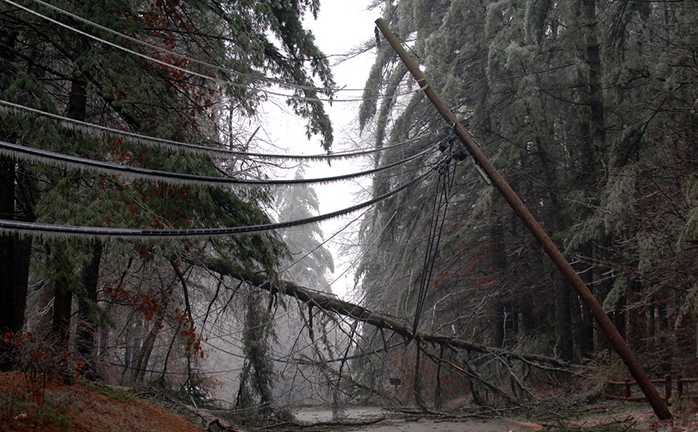Adapting the electricity grid to climate change
The European electricity grid delivers the electricity that our economy and our lifestyle depend on. This grid may be damaged by extreme weather events, which can lead to blackouts. The frequency and intensity of extreme weather events are likely to increase with climate change. If the grid is not adapted to a changing climate, the risk of electricity disruptions will increase with it.
The European electricity system is changing, driven by climate change mitigation policies: climate policies entail a rapid growth of intermittent renewable electricity supply that needs to be integrated into the European grid, requiring grid operators to take immediate measures. However, much less attention is paid to adapting the electricity grid to a changing climate. In what way is the electricity grid vulnerable to climate change and how could it be made more resilient?
The most frequent cause of blackouts
Power lines are vulnerable to extreme weather – in fact, it is the cause of most blackouts today. The “weakest link” in the face of weather extremes are not the transmission lines, which transport electricity across great distances to distribution points, but the distribution lines that link these points to neighbourhoods or single households. This is because many customers outside the population centres are served by only one distribution line, which may go through forests and thus be particularly vulnerable. One may think this is only a minor problem as it affects only a few households in the countryside. Yet, for example, in 2005 a devastating storm hit the west coast of southern Sweden. The combination of strong winds, falling trees and broken branches damaged several sections of the distribution grid. The result was thousands of households without electricity, some of them up to 45 days. The storm had an especially serious impact on the rural population and the rural companies situated within the major forest areas.
Whereas the distribution lines are the most vulnerable part of the grid, the transmission lines are not resistant to damage from extreme weather either: in 2003, some parts of Switzerland and the whole of Italy were blacked out for several hours, parts of Italy even for 18 hours. The trigger of the disruption was failure of a transmission line in Switzerland: it was overloaded and therefore overheated, causing it to sag too close to the ground and resulting in a flashover – a small lightning bolt – between the line and a tree. However, the consequences would have been the same if the line had been broken due to a flood, ice build-up, lightning, or branches blown by strong winds.
Adapting the grid to an uncertain future
If the climate is changing and the weather is getting more extreme, the electricity grid will be at increasing risk of damage. Precautionary measures such as minimising the exposure (burying power lines) or maximising the robustness of grid components (reinforcing pylons and overhead lines) may be useful and efficient today, with known frequencies of weather extremes. However, these measures may be neither sufficient nor cost-efficient in the face of a changing climate, with increasing frequency and intensity of extreme weather events. For example, if we design the power system to withstand a 100-year flood, it will not withstand a 200-year flood, which may become more frequent in the future.
Climate-proofing the system
The best adaptation measure to climate change, therefore, is to increase the resilience of the electricity system (see also the blog by Johan Lilliestam: How resilient is renewable electricity generation?): creating further interconnections, integrating national systems and voltage levels and improving coordination among network operators. Moreover, it is crucial that transmission lines do not operate at or near full load during normal conditions: this way, when one line goes down, the others can catch the load and the transmission system remains intact, with all consumers still online. Likewise, electricity networks today operate under the “n-1” principle, ensuring the electricity supply even after the failure of any one component of the power system. However, if a major transmission line is shut down and a second one is shut down immediately after – as was the case in the Swiss and Italian blackout – then it is no longer possible to secure uninterrupted supply. A power system designed under the “n-2” principle may be disrupted under extreme conditions, too, but a blackout is far less likely.
Although large-scale blackouts are still very unlikely events, an increase in frequency and intensity of extreme weather events can lead to immense costs and inconveniences for consumers, power companies and the whole of society. In order to prepare for the increasing risk of blackouts, our future efforts will have to focus on increasing the resilience of the electricity systems in addition to strengthening the individual links.
Further information
The Human-Environment Systems group is conducting research on how vulnerable the electricity grid is to extreme weather and other natural hazards, and how this vulnerability may develop in the future. The latter is especially important as energy security and system reliability will gain importance as Switzerland replaces nuclear power with renewables, and as the changing climate alters the natural conditions for both generation and transmission of electricity.


